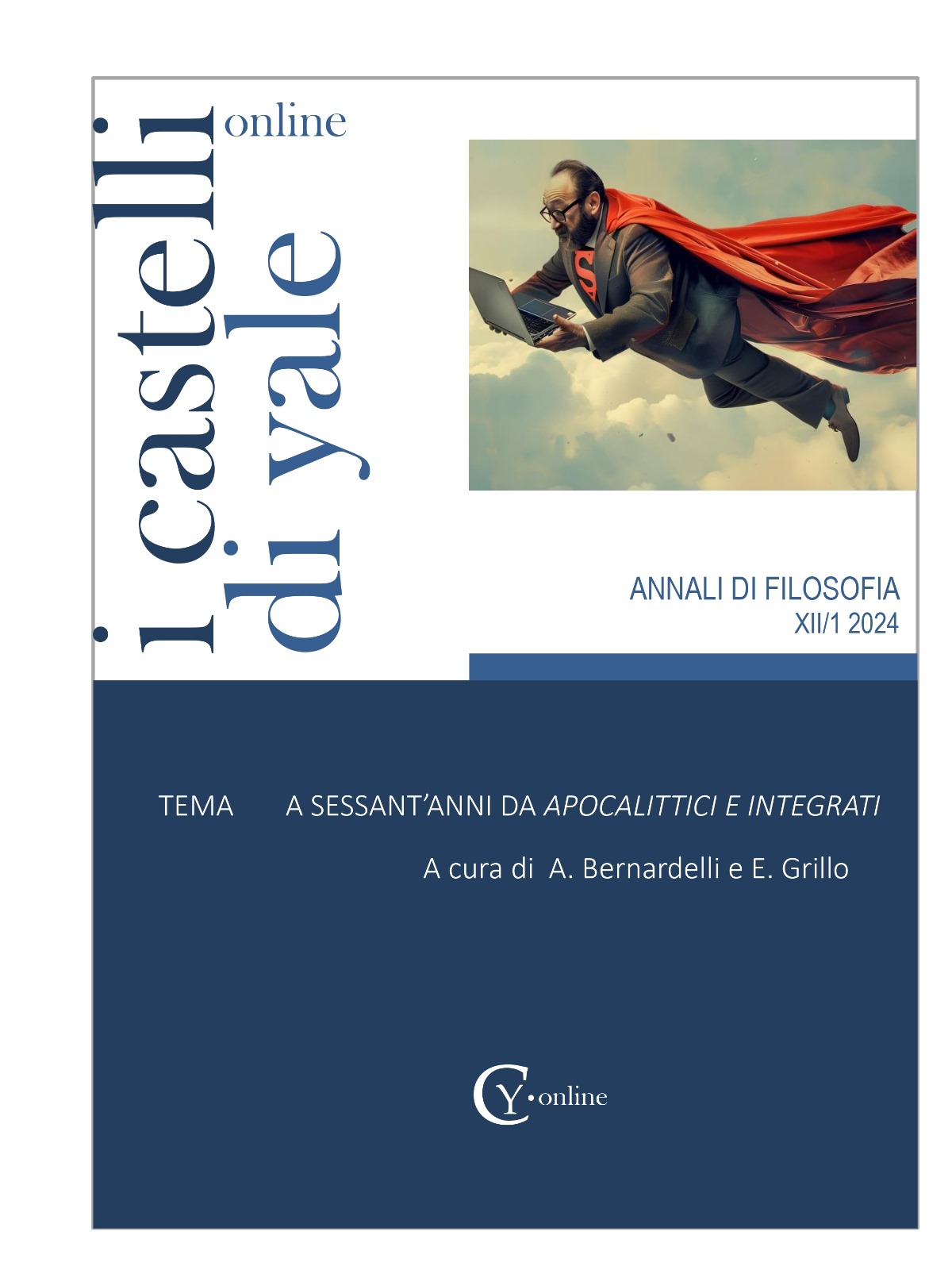Ragione e sentimento
Peripezie della catarsi da Apocalittici e integrati ai media digitali
DOI:
https://doi.org/10.15160/2282-5460/2836Keywords:
Catharsis, Media Effects, Apathy, Critical Sensibility, SemioticsAbstract
The article addresses three different interpretations of the concept of catharsis in three different texts: Apocalittici e integrati (Eco 1964), Montani (2020) and Bolter (2019). Despite substantial modifications, after sixty years the concept of catharsis still indicates the problem of media products’ effects on the consumers and the different positions about it, whether they would be “apocalyptic”, enthusiastic, or neutral. After an examination of these three texts, the article puts forth a semiotic interpretation, according to which media products entail a “sender” function of a “using program”, which subjects have to make “instable” or “plural” in order to make their use less mechanical. Thus, subjects could enable a wider range of responses, in order to manage the possible effects more consciously. In this way, the old contrast between media enthusiasts and detractors can be seen as a non-exclusive opposition.
References
Abruzzese, A. (2014). Essere apocalittici e integrati. In A.M. Lorusso (a cura di), 50 anni dopo Apocalittici e integrati (31-32). Milano: Alfabeta2, DeriveApprodi.
Abruzzese, A. & Borrelli, D. (2000). L’industria culturale. Tracce e immagini di un privilegio. Roma: Carocci.
Barthes, R. (1964). Éléments de sémiologie. Communications, 4, 91-135.
Barthes, R. (1980). La chambre claire. Note sur la photographie. Paris: Cahier du cinéma/Gallimard/Éd. du Seuil.
Bassano, G. (2023). Verso. Strutture semiotiche della destinazione. Roma: Studium.
Bolter, J.D. (2020) [2019]. Plenitudine digitale. Il declino della cultura d’élite e lo scenario contemporaneo dei media. Roma: Minimum Fax (ed or. The Digital Plenitude: The Decline of Elite Culture and the Rise of New Media. Cambridge (Mass.): MIT Press).
Cimatti, F. (2017). C’è qualcosa oltre la lingua? Barthes e il problema del “fuori senso”. In M.W. Bruno & E. Fadda (a cura di), Roland Barthes Club Band (47-59). Macerata: Quodlibet.
Cohen-Séat, G. (1961). Problèmes du Cinéma et de l’Information Visuelle. Paris: PUF.
Eco, U. (1962). Del modo di formare come impegno sulla realtà. Il menabò, 5, 198-237 (poi in Id., Opera Aperta. Forma e indeterminazione nelle poetiche contemporanee, Milano, Bompiani, IV ed. 1976, 235-290).
Eco, U. (1964). Apocalittici e integrati. Comunicazioni di massa e teorie delle comunicazioni di massa. Milano: Bompiani.
Eco, U. (2013). Accostamento pragmatico alla definizione dell’esperienza estetica. In P. Leonardi & C. Paolucci (a cura di), Senso e sensibile. Prospettive tra estetica e filosofia del linguaggio (81-84). E/C. Rivista dell’Associazione Italiana di Studi Semiotici, Serie Speciale, 17.
Fabbri, P. (2023). Ancora la catarsi?. In Id., La svolta semiotica. Nuova edizione accresciuta (259-280). Milano: La nave di Teseo.
Florea, M. (2013). Media violence and the cathartic effect. Procedia-Social and behavioral sciences, 92, 349-353.
Gentile, D.A. (2013). Catharsis and Media Violence: A Conceptual Analysis. Societes, 3(4), 491-510: https://doi.org/10.3390/soc3040491.
Marrone, G. (1990). Il sistema di Barthes. Milano: Bompiani.
Montani, P. (2020). Le emozioni dell’intelligenza. Un percorso nel sensorio digitale. Milano: Meltemi.
Negrea, X. (2017). Catharsis and Credibility in Today Media Space. Annals of the University of Craiova for Journalism, Communication and Management, 1(3), 144-162.
Panosetti, D. (2014). “Apocalittico sarà lei”. Intervista a Umberto Eco. In A. M. Lorusso (a cura di), 50 anni dopo Apocalittici e integrati di Umberto Eco. Milano: Alfabeta.
Ricœur, P. (1983-1985). Temps et récit (Vols. 1-3). Paris: Éditions du Seuil.
Rizzolatti, G. et al. (1992). Understanding motor events: a neurophysiological study. Experimental Brain Research, 91, 176–180: https://doi.org/10.1007/BF00230027.
Soon Khoo, G. & Oliver, M.B. (2013). The therapeutic effects of narrative cinema through clarification: Reexamining catharsis. Scientific Study of Literature, 3(2), 266-293.
Vygotskij, L.S. (1972) [1925]. Psicologia dell’arte. Trad. it. di A. Villa. Roma: Editori Riuniti.
Vygotskij, L.S. (1986). Lezioni di psicologia. Trad. it. di L. Mecacci. Roma: Editori Riuniti.
Westwood, R. (2004). Comic Relief: Subversion and Catharsis in Organizational Comedic Theatre. Organization Studies, 25(5), 775-795.
Downloads
Published
Issue
Section
License
Copyright (c) 2024 Eduardo Grillo

This work is licensed under a Creative Commons Attribution-NonCommercial-NoDerivatives 4.0 International License.


